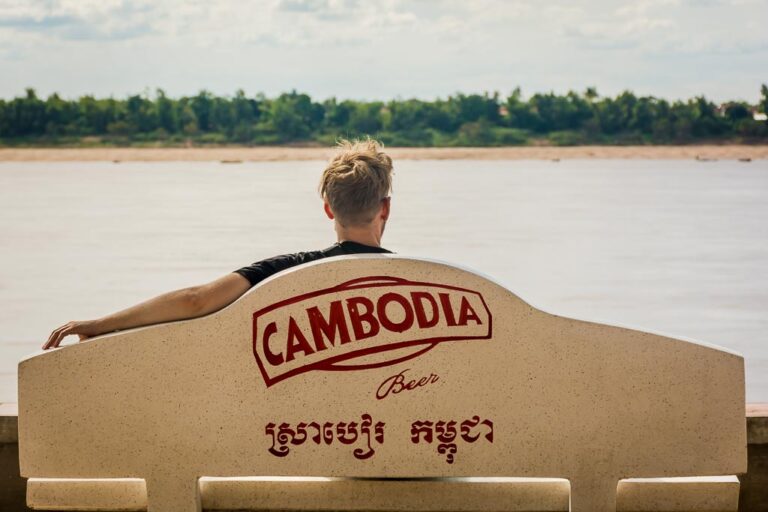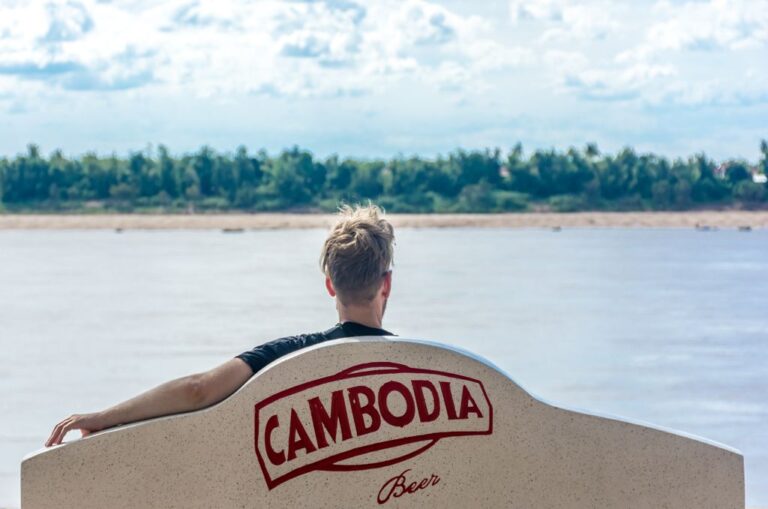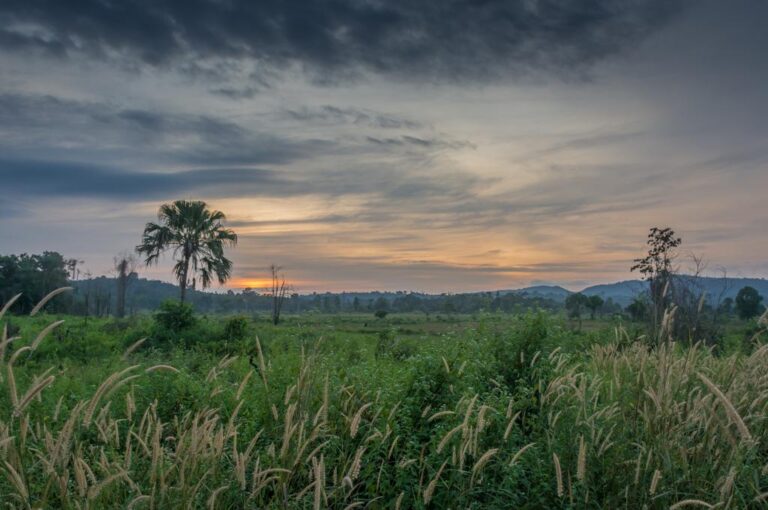Cambodia, the historical heart of Southeast Asia
Underneath the turbulent history, Cambodia still managed to keep its smile. A country that is home to a world wonder: Angkor Wat, an unspoiled coast line and delicious curries. The most memorable experience however will be the generous and friendly people you will meet on your way. Read on to discover this welcoming country and make most of your travel in Cambodia.
Table of Contents
The different regions in Cambodia
Cambodia consists out of 25 provinces but most travelers only visit a handful. On a 2-3 week itinerary the most interesting regions are: Phnom Penh (the capital), Siem Reap, Battambang, Koh Rong (with Sihanoukville), Kampot & Kep. The main point of interests are all situated on a line starting in the North (Siem Reap) and ending in the South-West at the coast in Sihanoukville. Underneath you can find a small summary of what every region has to offer:
- Siem Reap: Angkor Wat, floating villages and a bustling nightlife
- Phnom Penh: historic genocide sites, prison 21 and the killing fields
- Kratie: endangered (Irrawady) dolphin spotting
- Sihanoukville: coastal (party) nightlife and main gateway to some desolated islands
- Otres beach: perfect white beach getaway
- Koh Rong Samloem: unspoiled laidback island life
- Kampot: green mountains and the famous Bokor hill station
- Kep: French colonial villas next to the beach, also called the Saint-Tropez of Cambodia
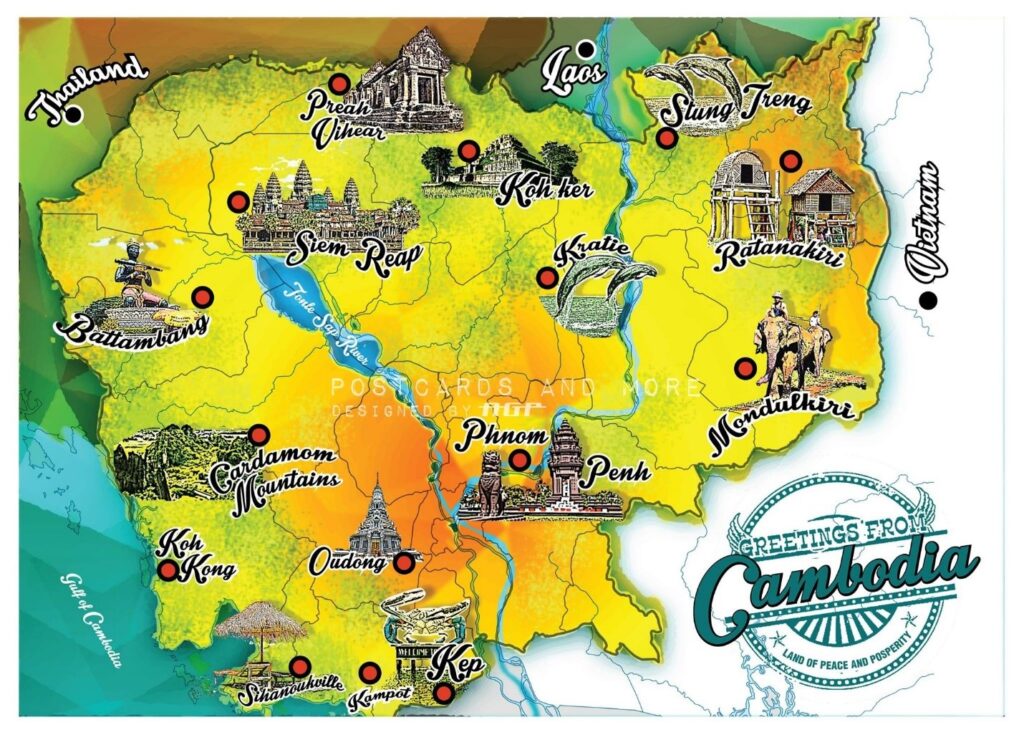
Itineraries
When you are heading to Cambodia it is possible to see all the important highlights in 2 weeks. However if you really want to get to know the country a 3 week itinerary is more advisable. Below, you can find different itineraries through Cambodia. Depending on your own preferences, we are sure you can adapt one of these itineraries to your own taste.
Three weeks of travel in Cambodia
This is the itinerary we used for our travels to Cambodia and we loved it! If ancient cultures, a good portion of nature, a few cocktails at the beach and visiting some historic sites is your kind of vacation, this is the perfect itinerary for you!
Two weeks of travel in Cambodia
If you only have limited time for your travels to Cambodia, we have an alternative 2 weeks itinerary where you can see the most important sights of Cambodia.
Top things to do when you travel in Cambodia
- Watch the sunrise over Angkor Wat and wander around in ancient emperor times.
- Linger around in the tourist bubble of Siem Reap near Pub street and eat a tarantula or scorpion if you feel adventurous.
- Learn all about the Khmer Rouge and the horrors that Cambodian people had to endure by visiting the killing fields and prison 21. Read more about Phnom Penh and Tuol Sleng in this blog post.
- Spend some time in Sihanoukville and watch the sun go down while sipping a cocktail at Otres beach
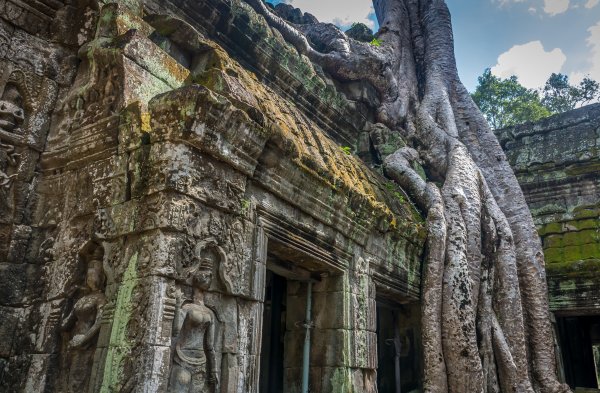
Off the beaten track
- Discover endangered Irrawady dolphins in the Mekong.
- Imagine how it must have been to play poker in an illegal casino at Bokor hill station in Kampot.
- Set sail to a desolated island at Koh Rong Samloem.
- Hire a scooter and go wildlife spotting in Ream National Park (Sihanoukville). Discover here how you can visit this park independently.
- Hike through unspoiled nature at the Cardamom mountains
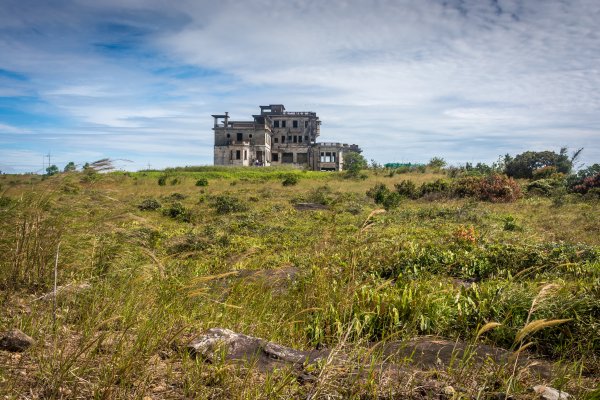

Visa
In order to enter Cambodia, you need a visa. If you fly in by plane you can easily obtain a visa on arrival. A visa will cost you 35 USD. Keep in mind that they also ask for a recent photo of 2 by 2 inches. If you don´t have one with you, you pay 2 dollars extra. The visa is valid for a stay of 30 days in Cambodia.
Travel costs for travel in Cambodia
The official currency in Cambodia is the Cambodian riel (1 USD = 4100 KHR). However in most restaurants and hostels you will see prices in dollar. In fact Cambodians prefer that you pay in dollar. Don´t worry, in every major city there are enough ATMs and they all give you the option to withdraw dollars. As in most Asian countries, there is a fee for withdrawing cash. Withdrawing cash at an ATM is still our preferred method, conversion rates at currency exchange boots are not that great and some are corrupt. So better safe than sorry. Paying with a credit card is available at more touristy and bigger hotels and restaurants. Don´t expect to be able to pay with Visa or Mastercard in a local homestay or beach pub.
Traveling in Cambodia is very budget friendly. Our daily travel budget in Cambodia was 50 USD a day for two persons.
As a budget traveler expect to pay:
- 10-15 USD for a private room for two persons
- 2-4 USD for a delicious local dinner
- 5-10 USD a day for renting a scooter
- 3-5 USD for a taxi ride in the city center
- 37 USD entrance fee for Angkor Wat
- 1 USD or less for a fresh beer
Accommodation
It´s not hard to find good accommodations in Cambodia. If you stick to the most popular tourist cities you find a big selection of good quality places to sleep and hang out. Prices are reasonable and the quality is on par. Especially in Siem Reap (the gateway to visit Angkor Wat) you find dozens of accommodations with a choice ranging from dorms to high-end boutiques. Many hostels offer cool living rooms and even a swimming pool. If you want to spare a couple of dollars, show up in person and don’t book via a booking site. We found out that half the hostels try to sell their rooms higher online. Other than that, finding a good spot to sleep is very straightforward in Cambodia.
Transport/ getting around
The most common methods of transportation you will use are buses, tuktuks and airplanes. Below you can find a summary of different transport options.
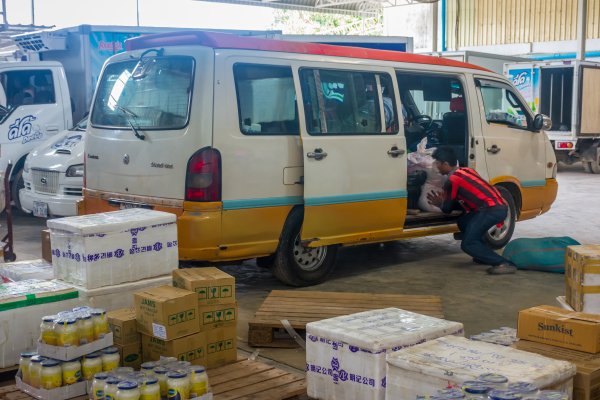
Bus
Taking a bus is the most popular method of transport when traveling in Cambodia. All the important towns are connected via a good bus network. Basically you have 3 options when buying a bus ticket.
- First are the night buses, which we don’t recommend. Normally we are big fans of taking sleeping buses to save some money (and time). But the amount of horror stories about accidents and bad drivers are simply not worth the risk in our opinion.
- Second it might sound tempting to book one of the so called “VIP minibuses” but we advise against it. The reason why? You risk to get scammed. One time we took a minibus that we booked via our hotel and it was not fun at all. We traveled 4 hours longer than expected and were cramped between 50 boxes of food and a mother that was breastfeeding here child the whole road long. Simply put, these VIP buses are used for logistics and food transport as well. You can’t blame the drivers though as they are looking for the most economical way to transport their goods, but when spending your vacation this might not be the most pleasant way of traveling.
- Third option (and our recommendation) is to buy a ticket at a booth from a private or even better, a government owned bus company. These are big buses that run daily between the major cities and you can’t go wrong with it. They don’t scam, prices are fixed and cheap (10 USD from Siem Reap to Phnom Penh for instance). The drivers are ok. We heard some stories but we never encountered any problems with reckless driving behavior or accidents.
Taking a plane
Prices for national flights are very reasonable and can save you some time if you only have 1 or 2 weeks to spend in Cambodia. For around 120 USD you can fly from Siem Reap in the North to Sihanoukville all down South. Flight operators like Airasia, Lionair and Angkor air offer daily flights between the major cities of Cambodia. So if you like to have a little more comfort while traveling between places, this is certainly a good option to look at.
Hiring a scooter
Honda waves are all over South-east Asia and we understand why. The amount of freedom you get and pleasure by navigating your own way through cities is amazing. For instance we did Angkor Wat by scooter and we totally loved it. We explored every corner of the temples at our own pace and loved the scenery around us.
When renting a scooter in Siem Reap to explore the temples of Angkor Wat, ask explicitly if their scooters are allowed to drive within the park. The reason why is that not all scooters are allowed to enter the park, it depends on the plates and taxes. Because of that, renting a scooter can be a little more expensive in Siem Reap than other places in Cambodia (around 15 USD/day compared to 5 USD/day). Another thing we recommend: Always take a mechanic instead of an automatic shifting gear. It not only has a lot more power when driving uphill, but it consumes half the fuel of an automatic scooter. Learning to drive with a semi-automatic scooter is really not that hard and is a skill that will definitely come in handy when traveling to other Southeast Asia countries.

Food
Cambodia is known for its ancient temples, pristine white beaches but also for its tasty cuisine. If you want to enjoy authentic Cambodian cuisine you have to look for restaurants that offer “Khmer food” on their menu.
Typical Kmer dishes are Amok, Lok Lak and Khmer curry. All these dishes are spiced up with typical Cambodian ingredients like eggplants, ginger, morning glory and bamboo shoots. Although Cambodian dishes can be spicy, it does not have the same heat as in India or Sri Lanka.
Our favorite dish was Lok Lak. This meal consists of fish served in a banana leaf together with coconut cream on the top and local spices like lemongrass, ginger and peanuts. If you ever travel to Cambodia, try it! You won’t regret it, even if you’re not a big fish lover like we are.
However if you do like fish you should go to Kep. In this pleasant little beach town you have a fish market that is famous for its crab. We did it as a day-trip with our scooter from Kampot. Here, you can find all the fish you can think off, freshly caught every day. In fact we saw even crab being caught on the spot, next to the market.
Although Cambodia has a unique food experience to offer, keep in mind that Cambodians eat everything. And you can take this quite literally! Don’t be shocked if you see tarantulas or scorpions on a stick or cobras in oil flasks to spice it up.
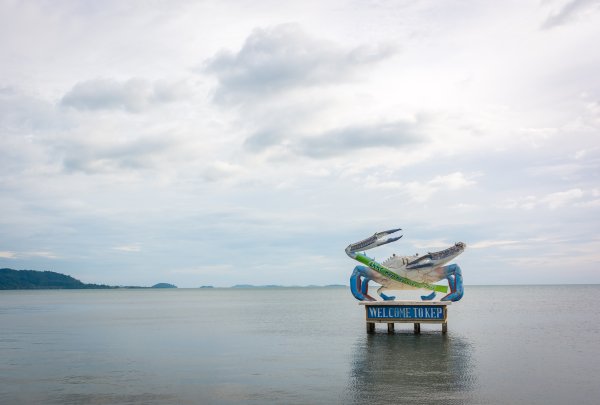
Internet
It gets harder and harder to find countries without good internet and Cambodia is no exception. Most accommodations in Cambodia provide free internet. Expect average speeds at 100kbps – 500 kbps. In other words this will suffice for moderate internet usage and watching some youtube videos (not in HD).
If you need internet on the go mobile data is easily available and very cheap. A prepaid sim-card is simple to obtain in most small shops. However try to buy one at a phone shop, preferably from the mobile carrier itself because that’s cheaper. A sim card costs about 2 USD. Our preferred carrier is Cellcard. They over the best coverage all over Cambodia and have a prepaid plan of 3 GB for 5 dollar. That’s even cheaper than in Belgium, so hard to beat if you ask us.
Tip: take your passport with you when buying a sim-card, as they need to take a copy of it for registering your account.
Health
First of all we always advice you to contact your general physician or medical doctor for precautions and medical advice. This section is only a way to inform you about possible medical precautions you can take and can never replace a consultation with a doctor.
Although there are cases of infectious diseases in Cambodia, the most frequent issues are an upset stomach. This being said, in the following sections we describe the biggest health concerns you can encounter and prepare for.
Tap water
Never drink water from the tap, always buy bottled water. And if you buy bottled water give the bottle cap a quick inspection because there are reports of filling up plastic bottles with tap water and selling it as bottled water. That’s the reason why you sometimes see bottle caps with plastic foil over it, that way if the seal is not broken you know it’s safe to drink.
Recommended vaccinations
Make sure you contact a medical doctor for an up to date status of your vaccinations. The following vaccinations are recommended by the official US Centers for Disease Control (CDC):
- Adult diphtheria and tetanus single booster recommended if none in the previous 10 years.
- Hepatitis A
- Hepatitis B
- Japanese encephalitis: Recommended for rural travel, people who will be doing outdoor activities or for anyone staying longer than 30 days.
- Polio
- Rabies: three injections in total. Keep in mind that even you are vaccinated you ALWAYS need to go to a hospital for a treatment if you get bitten by a dog, monkey, etc. This vaccination was a no-brainer for us.
- Typhoid
Mosquitoes
According to the CDC there are cases of Malaria. This means you have to take anti-malaria medication as prevention. Taking Malarone or other generic type of anti-malaria medication is advised. As always using mosquito repellent with DEET in it and sleeping under a mosquito net should be the first precaution you take.
Dengue is on the rise in Cambodia and Southeast Asia. There is a vaccination on the way, but for now using mosquito repellent and sleeping under a mosquito net is recommended. Same precautions apply to Japanese encephalitis and ZIKA. For more information it is always a good idea to check this website.
Conclusion
If you want to discover Southeast Asia, Cambodia should be on your travel list. From 6 months traveling in Asia, Cambodia is still one of those countries we have the best memories of.
Have you ever been to Cambodia? What were your experiences? Tell us all about it in the comments below.
Thanks for reading and if you have any questions, don’t hesitate to give us a shout!
Matthias & Mieke
